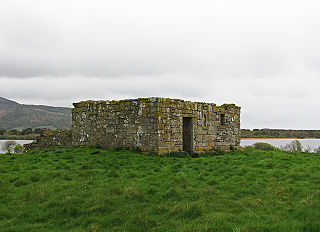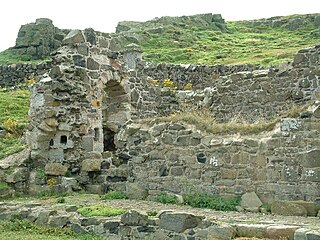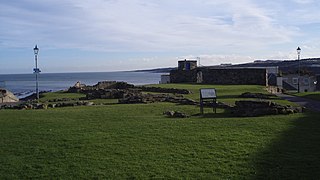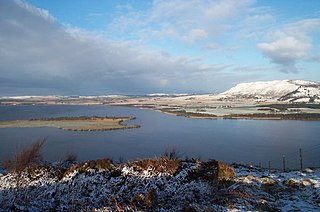Related Research Articles
The Culdees were members of ascetic Christian monastic and eremitical communities of Ireland, Scotland, Wales and England in the Middle Ages. Appearing first in Ireland and then in Scotland, subsequently attached to cathedral or collegiate churches; they lived in monastic fashion though not taking monastic vows.

St Andrews is a town on the east coast of Fife in Scotland, 10 miles southeast of Dundee and 30 miles northeast of Edinburgh. St Andrews had a recorded population of 16,800 as of 2011, making it Fife's fourth-largest settlement and 45th most populous settlement in Scotland.
Saint Serf or Serbán (Servanus) is a saint of Scotland. Serf was venerated in western Fife. He is called the apostle of Orkney, with less historical plausibility. Saint Serf is connected with Saint Mungo's Church near Simonburn, Northumberland. His feast day is 1 July.

Pittenweem ( ) is a fishing village and civil parish in Fife, on the east coast of Scotland. At the 2001 census, it had a population of 1,747.

Pittenweem Priory was an Augustinian priory located in the village of Pittenweem, Fife, Scotland.

Saint Fillan was a sixth-century Scottish monk active in Fife. His feast day is 20 June.
Saint Monan was a Christian missionary in Fife, probably a Gael. Little is known of him. Monan is believed to have lived at a monastery at Pittenweem before leaving to take up residence in a small cave at Inverey.

Scone Abbey was a house of Augustinian canons located in Scone, Perthshire (Gowrie), Scotland. Dates given for the establishment of Scone Priory have ranged from 1114 A.D. to 1122 A.D. However, historians have long believed that Scone was before that time the center of the early medieval Christian cult of the Culdees. Very little is known about the Culdees but it is thought that they may have been worshiping at Scone from as early as 700 A.D. Archaeological surveys taken in 2007 suggest that Scone was a site of real significance even prior to 841 A.D., when Kenneth MacAlpin brought the Stone of Destiny, Scotland's most prized relic and coronation stone, to Scone.

Whithorn Priory was a medieval Scottish monastery that also served as a cathedral, located at 6 Bruce Street in Whithorn, Wigtownshire, Dumfries and Galloway.
The Prior of St Andrews was the head of the property and community of Augustinian canons of St Andrews Cathedral Priory, St Andrews, Fife, Scotland. It was established by King David I in 1140 with canons from Nostell Priory, West Yorkshire. It is possible that, initially at least, the prior of St Andrews was subordinate to the bishop as abbot, but by the 13th century the canons of St Andrews were given freedom by the bishop to elect their prior. By the end of the 13th century, the abbacy of the native canons was no longer there to challenge the position of the priory, and the native canons themselves had been formed into a collegiate church.
The Prior of Loch Leven was the head of lands and of the community Augustinian canons of St Serf's Inch Priory, Loch Leven. There was a Scottish Céli Dé establishment there in the first half of the 12th century, allegedly found by Bruide, son of Dargart, King of the Picts (696–706). When the Augustinian priory was founded in 1150, the Scottish monks were absorbed into the established and those who refused to join were to be expelled. Not all of the priors are known. The most famous prior undoubtedly was the chronicler, Andrew de Wyntoun. Following more than four centuries of Augustinian monastic life and the resignation of the last prior, the Protestant king, James VI of Scotland, granted the priory to St Leonard's College, St Andrews.

The St Serf's Inch Priory was a community of Augustinian canons based, initially at least, on St Serf's Inch in Loch Leven, Perth and Kinross, Scotland.
Monymusk Priory was a house of Augustinian canons based at Monymusk in Mar, Aberdeenshire. It began as a Culdee foundation but later became Augustinian.
The Prior of May then Prior of Pittenweem was the religious superior of the Benedictine monks of Isle of May Priory, which later moved to the mainland became called Pittenweem Priory. The priory was originally based on the Isle of May, but was moved by 1318 to its nearby mainland site of Pittenweem, Fife, passing from the overlordship of Reading Abbey (Benedictine) to St Andrews Cathedral Priory (Augustinian). The following is a list of priors and commendators:

The Isle of May Priory was a monastery and community of Benedictine monks established for 9 monks of Reading Abbey on the Isle of May in the Firth of Forth, Scotland, in 1153, under the patronage of David I of Scotland. The priory passed into the control of St Andrews Cathedral Priory in the later 13th century, and in 1318 the community relocated to Pittenweem Priory on the Fife coast.

The Church of St Mary on the Rock or St Mary's Collegiate Church, was a secular college of priests based on the seaward side of St Andrews Cathedral, St Andrews, just beyond the precinct walls. It is known by a variety of other names, such as St Mary of the Culdees, Kirkheugh and Church of St Mary of Kilrymont.

Portmoak is a parish in Kinross-shire, Scotland. It consists of a group of settlements running north to south: Glenlomond, Wester Balgedie, Easter Balgedie, Kinnesswood, Kilmagadwood and Scotlandwell.

James Haldenston or James Haldenstoun was an Augustinian churchman from 15th-century Scotland. Probably from somewhere in eastern Fife, Haldenston became an Augustinian at St Andrews, earned several degrees on the continent, and became prior of May before becoming prior of St Andrews, head of the wealthiest and most important religious house in Scotland.

Simon was a 13th-century Augustinian canon based in the Kingdom of Scotland.
References
- ↑ Allaria, Anthony. "Priory of Saint Andrews." The Catholic Encyclopedia Vol. 13. New York: Robert Appleton Company, 1912. 25 August 2022
 This article incorporates text from this source, which is in the public domain .
This article incorporates text from this source, which is in the public domain . - ↑ Cowan, Ian B., & Easson, David E., Medieval Religious Houses: Scotland, With an Appendix on the Houses in the Isle of Man, 2nd Ed. (Longman, London and New York, 1976) p. 96, ISBN 0-582-12069-1
- ↑ Barrow, G.W.S., "The Clergy at St Andrews", in G.W.S. Barrow (ed.), The Kingdom of the Scots, (Edinburgh, 2003), pp. 189–202
- ↑ Duncan, A. A. M. “The Foundation of St Andrews Cathedral Priory, 1140.” The Scottish Historical Review, vol. 84, no. 217, 2005, pp. 1–37. JSTOR
- ↑ Hunter-Blair, Oswald. "Lochleven." The Catholic Encyclopedia Vol. 9. New York: Robert Appleton Company, 1910. 25 August 2022
 This article incorporates text from this source, which is in the public domain .
This article incorporates text from this source, which is in the public domain . - ↑ Keys, David. "Archaeology: Secrets of St Adrian's isle: The monks left May long ago, and today instead of pilgrims it attracts tourists and historians, including David Keys", The Independent, 3 August 1994
- ↑ Farnie, Henry Brougham. "Pittenweem", The Fife coast from Queensferry to Fifeness, Fife. J.C. Orr, 1860, p. 161
- ↑ "The Chapel of Portmoak", The Kinross-Shire Civic Trust
- ↑ Historic Environment Scotland. "St Andrews Cathedral and Priory and adjacent ecclesiastical remains (SM13322)" . Retrieved 16 April 2019.
- ↑ Sprott, George Washington (1899). . In Lee, Sidney (ed.). Dictionary of National Biography . Vol. 59. London: Smith, Elder & Co. pp. 352–353.
![]() This article incorporates text from a publication now in the public domain : Herbermann, Charles, ed. (1913). "Priory of Saint Andrews". Catholic Encyclopedia . New York: Robert Appleton Company.
This article incorporates text from a publication now in the public domain : Herbermann, Charles, ed. (1913). "Priory of Saint Andrews". Catholic Encyclopedia . New York: Robert Appleton Company.